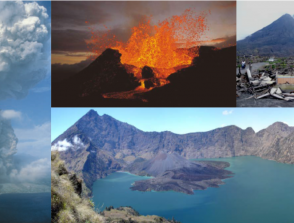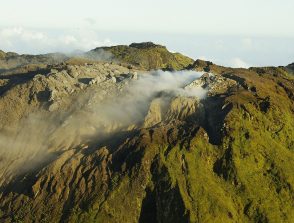Identification and modeling of physical processes of triggering and modulation of volcanic seismicity: applications to the Soufrière of Guadeloupe
Start: 01 October 2021
Supervisors :
Jean-Christophe Komorowski, Arnaud Burtin, Kristel Chanard
Related observatories :
Observatoire volcanologique et sismologique de la Guadeloupe (OVSG-IPGP)
Related teams :
Volcanic Systems
Status: In progress
Identification and modeling of physical processes of triggering and modulation of volcanic seismicity: applications to the Soufrière of GuadeloupeThe Soufrière of Guadeloupe presents a seismo-volcanic activity linked to an active hydrothermal system. This microseismicity is superficial (< 1km below the surface) and takes the form of swarms. Since 2018, the frequency of occurrence of swarms has increased without any direct cause between internal and/or external forcing being identified.
The catalogue of volcanic seismicity and the relative variations in seismic velocity (dV/V) show spatio-temporal evolutions that can inform us about the mechanisms controlling the Soufrière seismic swarms. Identifying the physical processes responsible for triggering and modulating seismic swarms at shallow depths is essential to assess the risk of phreatic eruption (pressurisation, overheating) as well as that linked to the gravitational instability of the volcano’s flanks, whose internal and external forcings to the volcanic system are numerous, complex and non-linear.
The potential links between certain non-tectonic deformations and the activation and evolution of seismic swarms is a subject of great importance, which is still being debated. These links are difficult to identify as they may involve diverse processes at multiple spatial and temporal scales. The methods classically used to establish these links require a priori assumptions about their physical causes or statistical properties, which are often unknown.
The objective of this thesis is to search for common modes of variability in the spatio-temporal evolution of seismicity with other physico-chemical parameters available for the Soufrière volcano (deformations, rainfall, fumarole, ground and spring heat fluxes…). This work will be based on an approach using a spectral analysis method: Multiple Singular Spectrum Analysis (M-SSA). M-SSA allows the extraction of quantified information on common structures (trends, periodicities, noise) from time series of data without prior knowledge of the dynamics of the underlying system.
The search for common modes of variability between the seismicity and many complementary data sets will help to identify the different mechanisms responsible for the seismic activity of La Soufrière and to associate them with different active zones of the system. Based on their identification, the common modes of variability will be the subject of first-order physical modelling aimed at establishing a robust link between seismicity and elastic, thermo- or poroelastic deformation in the host rock. The results of this thesis should therefore have implications in terms of detection of precursors of critical phenomena and integration with multiparameter monitoring networks and methods.





